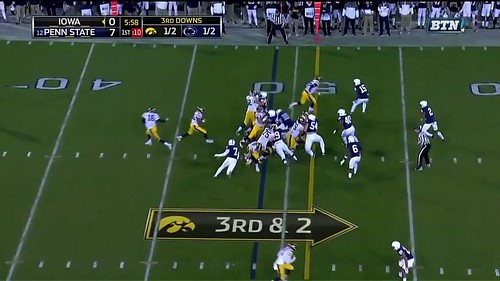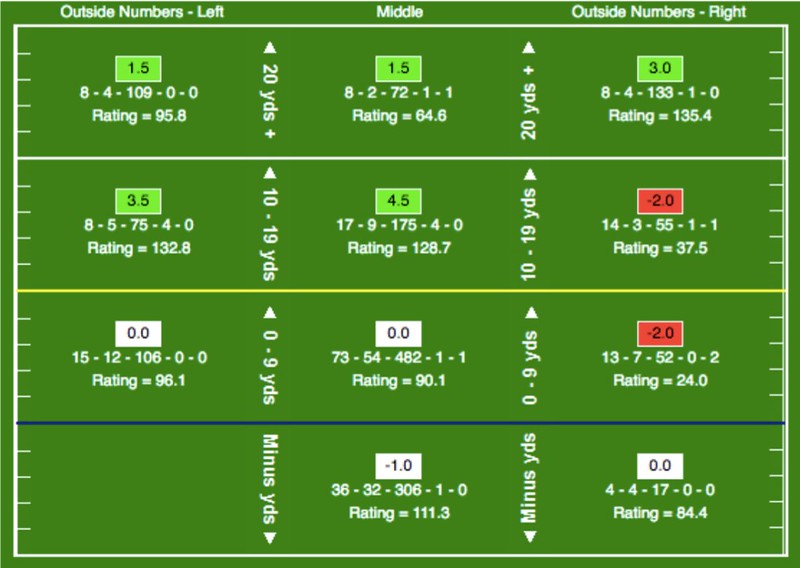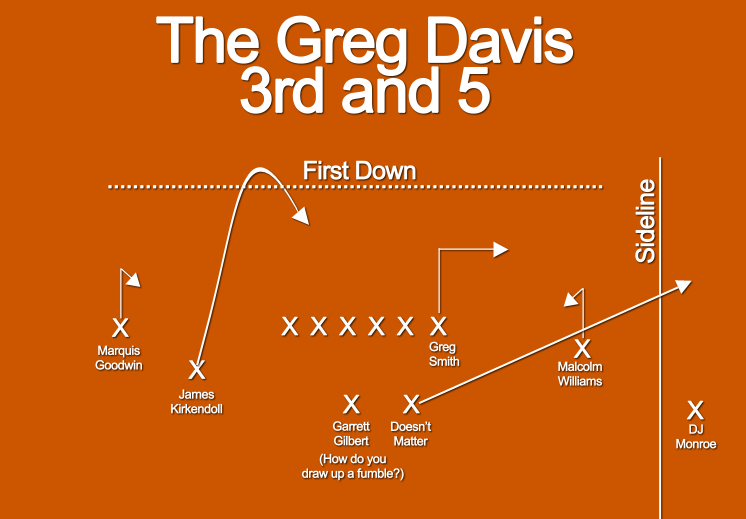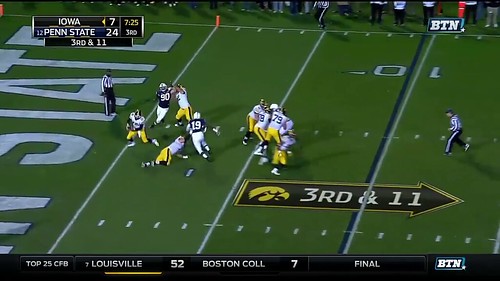Fee Fi Foe Film: Iowa Offense

Before I spent a moment working on this post, I knew what would be leading it off, because this came across my feed on Saturday.
Watch Penn State know Iowa's predictable play call pic.twitter.com/4pYTSGuNYZ
— Heavens! (@HeavensHawkeye) November 6, 2016
Is predictability bad? Let's find out. Iowa drives vs. Penn State:
- Seven-play, 75-yard touchdown drive to cut deficit to 21-7
- Four three-and-outs
- Two four-and-outs
- Eight-play, 40-yard drive, turnover on downs after failed QB sneak
- Eight-play, 23-yard drive, terrible CJ Beathard interception
- Nine-play, 81 yard touchdown drive when score was 41-7
Ah, so.
Personnel. Seth's diagram [click to embiggen]:
Due to a combination of ineffectiveness and injury, Iowa has started seven different combinations on the offensive line in nine games this season. Cole Croston, who began the season as the starting left tackle, is the primary reason for the near-weekly reshuffling; after struggling for five games at LT, culminating in an embarrassing performance against Northwestern's Ifeadi Odenigbo, he moved to RT, and ever since he's battled an ankle injury that's mostly kept him off the field.
It's unclear what the combination will be this time around. LG Boone Myers initially moved to LT to replace Croston, then started at RT last week after missing a game due to injury. Myers is listed as the starting LT this week; the starting LT from the last two weeks, Ike Boettger, is atop the depth chart at RT. No matter the alignment, the tackles have been mediocre, and Croston or his replacement (at this point, LG Keegan Render) has been a sore spot.
The receiving corps lost their best player, Matt VandeBerg, early in the season, and star tight end George Kittle has been playing at less than 100% since a mid-October leg injury.
Spread, Pro-Style, or Hybrid? Dinosaur.
Basketball on Grass or MANBALL? DeBordian devotion to zone. Every Iowa run play I noted was either an inside zone, outside zone, or incredibly obvious jet sweep to a running back lined up in the slot.
Hurry it up or grind it out? Iowa is the third-slowest team in the country by adjusted pace. This comes as a shock, I know.
[Hit THE JUMP for the rest of the breakdown.]
Quarterback Dilithium Level (Scale: 1 [Navarre] to 10 [Denard]): CJ Beathard can move around a bit, though injuries have slowed him the last year or so, and Iowa makes no effort to utilize him in the running game. He's averaging 3.9 YPC on 39 non-sack carries—even when he breaks the pocket, he's usually looking to pass. He gets a four.
Dangerman: Speedster Akrum Wadley can actually do exciting things with the football in his hands, so naturally he is the backup running back behind 225-pound bruiser LeShun Daniels. If you look at the season-long numbers, their stats are comparable enough that this could be justifiable; a closer look at how the two fare against good rush defenses, however, shows that this is a classic Kirk Ferentz decision in the "let's start a fullback at running back for three years" vein:
Wadley vs. top 20 S&P+ rush defenses: 33 carries, 179 yards (5.4 YPC), 1 TD
Daniels vs. top 20 S&P+ rush defenses: 37 carries, 119 yards (3.2 YPC), 0 TD
This even holds against good FCS teams:
Wadley vs. North Dakota State: 4 carries, 20 yards
Daniels vs. North Dakota State: 14 carries, 29 yards
While Daniels gets what's blocked for him and maybe a yard or two of YAC by pushing the pile, Wadley can make big plays happen on his own. He scored Iowa's first touchdown on a slip screen even though the play call was obvious—Greg Davis had dialed up the exact same play for a first down earlier on the drive and had only called one other play from the shotgun to that point. PSU had it dead to rights until they didn't:
Wadley will test the edge; after last week, that's a concern. The good news is Iowa is far less creative in how they attack the edge. Wadley got very little from two jet sweep handoffs because lining up your speedy tailback in the slot, as it turns out, is a bit of a tell.
Tight end George Kittle is a really good receiver when healthy, which hasn't been the case over the last month—he's caught four passes for 40 yards and no scores over his last three games. He's a superlative blocker, and that's held up even through injury, so despite not being a major threat in the passing game he's out there on every down. Of note: Kittle remains Iowa's second-leading receiver.
On the offensive line, right guard Sean Welsh is the standout. PFF grades him out at +9.1 in the run game, and that showed up on film time and again as Welsh would get much more push than his compatriots.

Welsh is shoving #54 past the first-down line. The left side didn't hold. One yard.
In addition to being strong, Welsh is nimble. He's the main driver of their zone running game. Watch Welsh (RG #79) help seal off a DT here, then get just enough of the linebacker to spring Daniels for a decent gain:
Welsh should hold up alright even against Michigan's interior D-line. The rest are in for a rough evening.
Zook Factor: Ferentz didn't have a classic Ferentz punt in this game, but the offense as a whole deserves to fall under this category. Despite falling behind big early, the Hawkeyes showed little urgency, and even when they finally spead it out and pushed the tempo a bit, they didn't go downfield at all. They waited until the last drive of the third quarter to go to the gun to start a drive; by that point they were down 27-7. That drive in its entirety:
- two-yard checkdown to Wadley
- ditto, but Wadley slips a tackle to pick up the first
- six-yard pass
- three-yard out on second-and-four
- I-form, 1 WR formation on third-and-one, Daniels stopped short as PSU sells out against run
- QB sneak converts fourth down
- errant checkdown to Wadley falls incomplete
- Beathard throws a terrible interception on a pass headed nine yards downfield
There's a reason we marked Greg Davis as a sore spot.
HenneChart: Beathard is a solid quarterback who's hamstrung by inept coaching. The vast majority of these throws were less than ten yards downfield:
| Opponent | DO | CA | MA | IN | BR | TA | BA | PR | SCR | DSR |
|---|---|---|---|---|---|---|---|---|---|---|
| PSU | 1 | 7* (6) | 1 | 2 | 1x | 2 | -- | 4 | -- | 62% |
Beathard's DO came on a ~15-yard dig that he perfectly placed between defenders in zone coverage. Iowa didn't throw that far downfield again in the portion I watched. (I stopped charting after Iowa went three-and-out in the fourth quarter following a PSU score to make it 34-7.)
PFF's pass chart says it all:

jfc greg davis
Only 31% of Beathard's "aimed" passes (excludes throwaways, batted passes, and throws with a simultaneous QB hit) have traveled farther than nine yards downfield. 20% of his aimed passes go behind the line of scrimmage. 36% go in one square: between the numbers 0-9 yards downfield.

The malpractice continues below.
OVERVIEW
FFS.
| Formations | Run | Pass | PA |
|---|---|---|---|
| Gun | -- | 14 | -- |
| I-Form | 4 | 1 | 4 |
| Ace | 9 | 4 | 1 |
| Pistol | -- | -- | -- |
| Heavy | 4 | -- | -- |
Shotgun runs have been legal since at least 2006, IIRC.
| Down | Run | Pass | PA |
|---|---|---|---|
| 1st | 8 | 7 | 2 |
| 2nd | 5 | 7 | 3 |
| 3rd | 4 | 5 | -- |
That down distibution looks pretty even, but that was driven entirely by game flow. This is how these charts looked when Iowa got the ball with 7:58 left in the second quarter, after four full drives:
| Formations | Run | Pass | PA |
|---|---|---|---|
| Gun | -- | 2 | -- |
| I-Form | 2 | -- | 3 |
| Ace | 6 | 1 | -- |
| Pistol | -- | -- | -- |
| Heavy | 1 | -- | -- |
| Down | Run | Pass | PA |
|---|---|---|---|
| 1st | 5 | -- | 1 |
| 2nd | 2 | 1 | 2 |
| 3rd | 2 | 2 | -- |
Davis began to open up the playbook a bit from here—the first play of the ensuing drive was a bubble screen, so technically a pass!—but even with the score at 24-7 in the second half the Hawkeyes were huddling, bleeding clock, and running zone stretch from I-form 2WR on first down. Iowa started trying to pick up the tempo and save face on Spartan time: well after the game was decided.
Let's get back to that video embedded at the top of the page, in which Beathard makes a check at the line and Brandon Bell (#11 on PSU) immediately knows the playcall, points where the ball is going, and unleashes the D-line for a TFL. This was not an isolated incident:
It's one thing to be predictably run-run-pass; it's another entirely to have opponents know your audibles and literally point to where the ball is going pre-snap.
This doesn't leave me with a whole lot to say about the personnel other than what's already been covered. The non-Welsh portions of the offensive line are mediocre-to-bad. Keegan Render, the aforementioned injury replacement, has a hard time holding his blocks—he's grading out at -7.0 on PFF with a relatively even split between run and pass negatives. If Ike Boettger is back at right tackle, I'd assume it's so Iowa can build up a strength running to that side with him next to Welsh; they're the two best run-blockers on the line, and Boettger is a clear step up in that regard from Boone Myers.
Both tackles will struggles with Michigan's edge rushers. PSU forced a throwaway on a three-man rush because Myers was beaten clean around the edge while Boettger got bull-rushed into Beathard's lap:

Interior pass-rush should also be a factor. Here's a reason why Render is a sore spot:
Yikes.
Mediocre blocking and extremely conservative playcalling doesn't give the receivers much chance to show their ability. Slot-type Riley McCarron is the most frequent target; he mostly works underneath, and while he's reliable, he isn't much of a big-play threat. Jerminic Smith is the nominal field-stretcher, but downfield shots are so obvious that he's only catching 50% of his targets—he averages 7.1 YPT. Those two get the vast majority of the receiver snaps; Iowa rarely goes three-wide until it's face-savin' time, and third receiver Jay Scheel has all of five receptions this season.
That might work out okay if the second tight end was a receiving threat. That is not the case. Noah Fant and Nate Pekar have combined for five catches for 35 yards this season, all by Fant; the two have played a combined 273 snaps. Neither is a particularly impactful blocker, either. The fullbacks are also blockers only; three have combined to catch two passes for 11 yards.
This is an offense so predictable that the defense often knows the play before it happens, and they have one real playmaker. That's not going to work against Michigan.
November 10th, 2016 at 3:41 PM ^
Sent from MGoBlog HD for iPhone & iPad
November 10th, 2016 at 3:59 PM ^
so of course iowa will change it up completely saturday ... i am confident we will be ready for the aggressive nothing to lose game they will call saturday.
November 10th, 2016 at 5:41 PM ^
November 10th, 2016 at 9:06 PM ^
November 10th, 2016 at 9:56 PM ^
November 11th, 2016 at 12:40 PM ^
If it was noon in Ann Arbor, I'd be thinking 50-6. Night in Iowa City has me a little more concerned that we might bust a play or two on defense and give them a long play but I'm still not worried. Probably going to be like 49-10

Comments